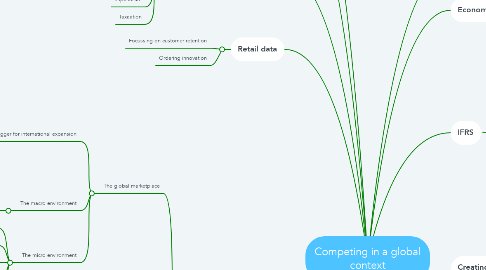
1. Competing in the global trade environment
1.1. The diamond model
1.2. The five forces of competition
2. Economic and financial flows
2.1. Balance payments
2.2. Foreign direct investmenst
3. Transfer pricing
3.1. Arm's length princile
3.2. Transfer mispricing
3.3. Unitary taxation with profit apportionment
4. Foreign exchange market
4.1. Supply of pounds to foreign market
4.2. Demand for pounds abroad
4.3. Equilibrium in the market
4.4. Shift in demand
4.5. Changes in supply
5. Financial regulation evolves
5.1. Stewardship
5.2. Managing the national economy
5.3. Info for investors
5.4. Borrowed finery
5.5. Imperialism
5.6. Taxaation
6. IFRS
6.1. Standards
6.1.1. Transparency
6.1.2. Accountability
6.1.3. Efficiency
6.2. Global accounting standards, not-for-profit, public interest
6.3. Jurisdiction profile
6.3.1. Survey
6.3.2. Public commitment
6.3.3. Applying standards
6.3.4. Endorsement
6.3.5. Modiifications
6.3.6. Process
6.3.7. Adoption
7. Retail data
7.1. Focussing on customer retention
7.2. Ordering innovation
8. Creating urban environments of the future
8.1. Autonomy
8.2. Participation
8.3. Sharing
8.4. Transformation
9. International marketing
9.1. The global marketplace
9.1.1. Trigger for international expansion
9.1.1.1. Saturated domestic markets
9.1.1.2. Small domestic markets
9.1.1.3. Low-growth domestic markets
9.1.1.4. Customer drivers
9.1.1.5. Competitive forces
9.1.1.6. Cost factors
9.1.1.7. Portfolio balance
9.1.2. The macro environment
9.1.2.1. STEEPLE
9.1.3. The micro environment
9.1.3.1. The market size and growth rate
9.1.3.2. Competition
9.1.3.3. Cost of serving the market
9.1.3.4. Profit potential
9.1.3.5. Market access
9.2. Entering and operating in international markets
9.2.1. Modes of entry
9.2.1.1. Indirect exporting
9.2.1.2. Direct exporting
9.2.1.3. Joint venture
9.2.1.4. Strategic alliances
9.2.1.5. Global strategic partnership
9.2.1.6. Lincensing
9.2.1.7. Franchising
9.2.1.8. Contract manufacturing
9.2.1.9. Management contracting
9.2.1.10. Direct investment
9.2.2. Globalisation versus customisation
9.3. Branding
9.3.1. Brand identity
9.3.2. Brand reputation
9.3.3. Brand equity
9.3.4. Brand content
9.3.5. Brand architecture and naming
9.3.6. Role of brands for organisations
9.3.7. Role of brands for customers
9.3.8. Logos
9.3.9. Packaging and labeling
9.4. Innovating and branding in a global context
9.4.1. Innovation
9.4.2. Global and local branding
9.4.3. Brand tribes and brand communities
9.4.4. Critical reflections on branding
